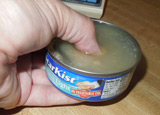How Much is inside Dreyer's Slow Churned Ice Cream?
Is Slow-Churned Ice Cream Whipped up with Extra Air?
By Rob Cockerham |
How Much is inside Dreyer's Slow Churned Ice Cream?
How Much is inside Dreyer's Slow Churned Ice Cream? No one knows.
This super sexy-sounding ice cream purports to have 1/3rd fewer calories and 1/2 the fat of regular ice cream... how could this be? Does the slow churning burn off some oil, leaving only fresh strawberries behind?

No, of course not. The low calorie ice cream is made by using a lower fat combination of milks... Less actual fat.
But, if you've ever picked up a carton of Slow Churned ice cream, you'll notice something. The carton weighs less.
Now, it seemed a little counter-intuative, but I learned from a milk-truck driver that a milk truck full of non-fat weighs more than a milk truck full of regular.

The fat weighs less than water (making it bouyant), and if you replace that fat with water, you end up with a heavier product. Weighing the two products (in their containers), I found:
1.5 quart container of neopolitan Rich & Creamy ice cream: 845 grams.
1.5 quart container of neopolitan Slow Churned ice cream: 720 grams.
The slow churned, despite being made with heavier materials, weighed only 85% as much as regular ice cream. What could make up this difference in weight?
I had two theories. Either the regular ice cream contains depleted uranium, or the Slow Churned version contains more air. But how much air is in there? On Monday night, we decided to find out.
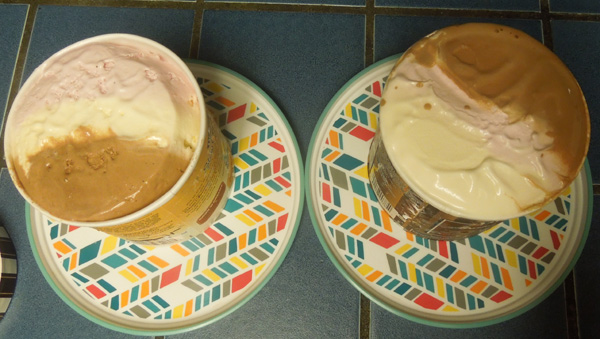
All ice creams are pretty solid, expecially when you try to scoop some out of a frozen block. So to find out how much of the frozen treat was actually air, we needed to melt the ice cream back into its liquid components.
I'm an ace at melting things, but in this case, using hair-dryers and tubs of warm water was overkill. We just set them outside and let the sun do its work.
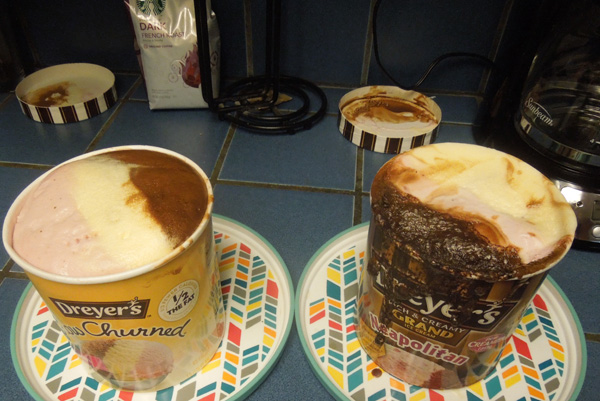
Well, actually, it was night, when we started this project so we first had to let the moon do its work. Ten hours later, the volume of ice cream had hardly budged. Both containers were almost overflowing with creamy foam.
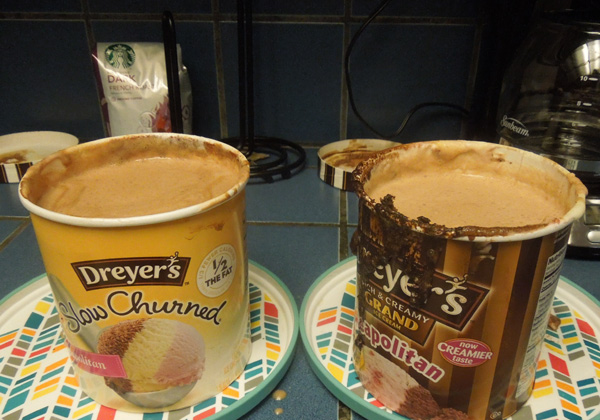
Even when I mixed them, breaking some of the bubbles, the volume didn't drop much, just an inch or so below their previous height. This wasn't very impressive. I put the containers back outside for another visit with their arch-nemesis, the sun.
After 10 more hours, the containers still looked mostly full of brown foam.
But then I took them inside and dropped them onto the counter. BOOM. Like two falling souffles, the bubbles on top burst, and slid down to about the halfway mark on the containers.

Wow! Both products had both been chock full of air!
After double-checking the weights from the night before, I could tell that a small amount of weight was missing, (10 grams) presumably lost to evaporation. Other than that, the weights were the same. The only thing that had changed was the volume.
I could have measured the amount of Dreyer's liquid with a meauring cup, but I used a ruler instead.
The Rich and Creamy ice cream, from a previous depth of 13 cm, had fallen to 6.7 cm. A fall of 48%. This indicated that the ice cream had been whipped up as it froze, to a 13/12 fluid/air ratio.
Next we checked the Slow Churned carton.
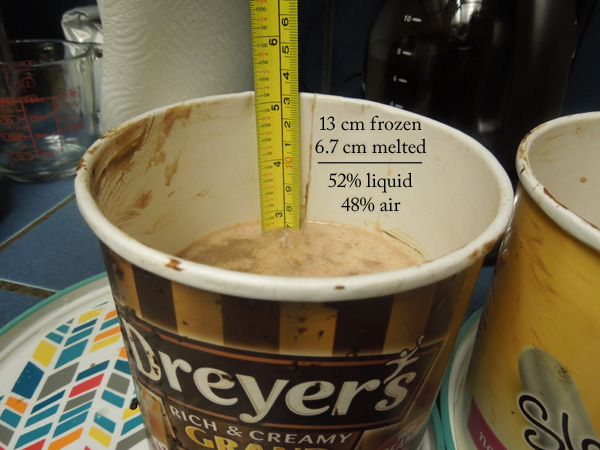
The Slow Churned was even worse. From a previous height of 13 cm, the slow churned was now down to the 6 cm mark, less than half as high as it had been previously.
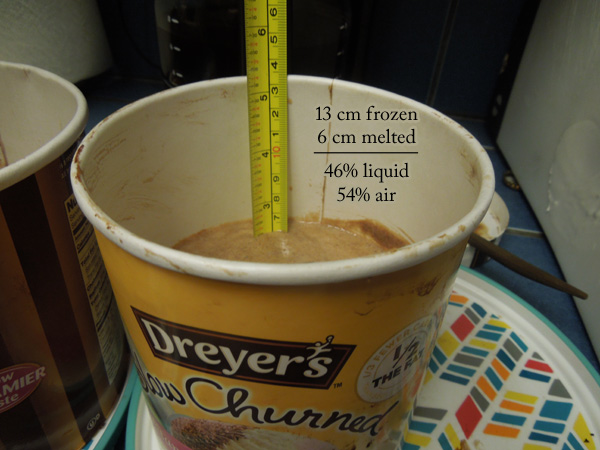
Sure enough, the Slow Churned ice cream had 10% more air, but the real story was in how much air was in their regular ice cream! 48%!

Check it out. Once melted, the ice cream fluid from both cartons fits into a single container, with room to spare. All I need is a clear domed lid and a green straw and I've invented the next creamy treat from Starbucks!

In case you were wondering, Dreyer's slow churning process doesn't have anything to do with churning.
This newish ice cream is made using a process called low-temperature extrusion. This technique uses equipment which operates at a lower temperature, -20° C instead of a mere -5°C, allowing them to keep the ice crystal formations super small, resulting in a creamy taste, even though there isn't much actual cream inside.
So what if they sell you half a carton of air? You LOVE when air tastes this good.


